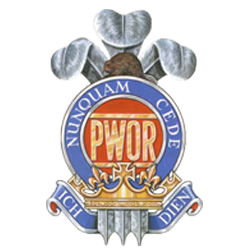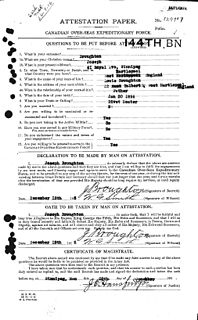
The Queen's Own Rifles of Canada is a Primary Reserve regiment of the Canadian Armed Forces, based in Toronto. The regiment is part of 4th Canadian Division's 32 Canadian Brigade Group. It is the only reserve regiment in Canada to currently have a parachute role. The regiment consists of the reserve battalion, the Regimental Association, and the Regimental Band and Bugles. The official abbreviation is The QOR of C, but the name is often abbreviated to QOR.

The Royal Canadian Regiment is an infantry regiment of the Canadian Army. The regiment consists of four battalions, three in the Regular Force and one in the primary reserve. The RCR is ranked 9th in the order of precedence amongst Canadian Army regiments, but is the most senior infantry regiment that has regular force battalions.

The British Columbia Regiment is a Primary Reserve armoured reconnaissance (recce) regiment of the Canadian Army; the regiment is subordinate to 39 Canadian Brigade Group of the 3rd Canadian Division. Established in 1883, it is the oldest military unit in Vancouver, British Columbia. It parades at the Beatty Street Drill Hall at the corner of Dunsmuir and Beatty in downtown Vancouver. The regiment has been variously designated as garrison artillery, rifles, infantry, and armoured, but has been reconnaissance since 1965. It has received 41 battle honours in its history, and has been a unit of the Royal Canadian Armoured Corps since 1942.

The Princess of Wales' Own Regiment (PWOR) is a Primary Reserve infantry regiment of the Canadian Forces.
The 171st Battalion, CEF was a unit in the Canadian Expeditionary Force during the First World War. Based in Quebec City, Quebec, the unit began recruiting during the winter of 1915/16. After sailing to England in November 1916, the battalion was absorbed by the 148th Battalion, CEF, 5th Pioneers, and the 20th Reserve Battalion in December 1916. The 171st Battalion, CEF had one Officer Commanding: Lieut-Col. Sir Wm. Price.
The 179th Battalion, CEF was a unit in the Canadian Expeditionary Force during the First World War. Based in Winnipeg, Manitoba, the unit began recruiting during the winter of 1915/16 in that city. After sailing to England in October 1916, the battalion was absorbed into the 17th Reserve Battalion on October 21, 1916. The battalion was disbanded on 17 July 1917. The 179th Battalion, CEF had one Officer Commanding: Lieut-Col. J. Y. Reid.
The 127th Battalion, CEF was a unit in the Canadian Expeditionary Force during the First World War. Based in Toronto, Ontario, the unit began recruiting in late 1915 in York County. After sailing to England in August 1916, the battalion was redesignated the 2nd Battalion, Canadian Railway Troops on November 8, 1916. The 127th Battalion, CEF had one Officer Commanding: Lieut-Col. F. F. Clarke, DSO.

§
The 190th Battalion, CEF was a unit in the Canadian Expeditionary Force during the First World War. Based in Winnipeg, Manitoba, the unit began recruiting during the winter of 1915/16 in that city and surrounding district. After sailing to England in May 1917, the battalion was absorbed into the 18th Reserve Battalion on May 14, 1917. The 190th Battalion, CEF had one Officer Commanding: Lieut-Col. G. K. Watson.
The 198th Battalion, CEF was a unit in the Canadian Expeditionary Force during the First World War. Based in Toronto, Ontario, the unit began recruiting during the winter of 1915/16 from The Queen's Own Rifles of Canada, which was based in that city. After sailing to England in March 1917, the battalion was absorbed into the 3rd Reserve Battalion on March 9, 1918. The 198th Battalion, CEF had one Officer Commanding: Lieut-Col. J. A. Cooper.
The 203rd Battalion, CEF was a unit in the Canadian Expeditionary Force during the First World War. Based in Winnipeg, Manitoba, the unit began recruiting during the winter of 1915/16 in that city. After sailing to England in October 1916, the battalion was absorbed into the 18th Reserve Battalion on January 12, 1917. The 203rd Battalion, CEF had one Officer Commanding: Lieut-Col. Jeffrey E. Hansford.

The Royal Regina Rifles is a Primary Reserve infantry regiment of the Canadian Army. Prior to 1982 the regiment was known as The Regina Rifle Regiment. The Royal Regina Rifles are part of 3rd Canadian Division's 38 Canadian Brigade Group.

The Saskatchewan Dragoons is a Primary Reserve armoured regiment of the Canadian Army. The unit is based in Moose Jaw. Their primary job is to assist the Regular Force in meeting Canada's military commitments. Their training and equipment closely follow that of the Regular Force, which the Reserves are called upon to assist increasingly often. The Saskatchewan Dragoons are part of 3rd Canadian Division's 38 Canadian Brigade Group.
The 244th Battalion, CEF was a unit in the Canadian Expeditionary Force during the First World War. Based in Montreal, Quebec, the unit began recruiting in the spring of 1916 in Montreal and the surrounding district. After sailing to England in April 1917, the battalion was absorbed into the 23rd Reserve Battalion, CEF later that month. The 244th Battalion, CEF had one Officer Commanding: Lieut-Col. E. M. McRobie.
The 255th Battalion, CEF was a unit in the Canadian Expeditionary Force during the First World War. Based in Toronto, Ontario, the unit began recruiting late in 1916 from The Queen's Own Rifles of Canada, which was based in that city. After sailing to England in June 1917, the battalion was absorbed into the 12th Reserve Battalion, CEF upon arrival. The 255th Battalion, CEF had one Officer Commanding: Lieut-Col. G. C. Royce.

The 8th Canadian Infantry Brigade was an infantry brigade of the Canadian Army that saw active service during World War I and World War II as part of the 3rd Canadian Infantry Division. The brigade fought on the Western Front during World War I from December 1915 to November 1918, and in Normandy and north-west Europe in 1944–1945 during World War II. It was a square formation of four infantry battalions during World War I, but was reduced to a triangular formation of three battalions during World War II.

Not to be confused with Victoria Rifles

The 3rd Battalion, Canadian Expeditionary Force was a battalion of the Canadian Expeditionary Force that saw service in the First World War.

The 2nd Canadian Mounted Rifles Battalion, was authorized on 7 November 1914 as the 2nd Regiment, Canadian Mounted Rifles, CEF. The battalion recruited in Victoria and Vernon, British Columbia and was mobilized in Victoria. An earlier incarnation was raised for Boer War.

The 259th Battalion, Canadian Rifles, CEF (Siberia), was an infantry battalion of the Canadian Expeditionary Force Siberia during the Great War. The 259th Battalion was authorized on 1 November 1918 and embarked for Russia on 22 and 26 December 1918. The unit disembarked at Vladivostok on 12 and 15 January 1919 where it served with the 16th Infantry Brigade as part of the Allied Forces in eastern Russia until 19 May 1919. The battalion disbanded on 6 November 1920.
Meek, John F. Over the Top! The Canadian Infantry in the First World War. Orangeville, Ont.: The Author, 1971.














